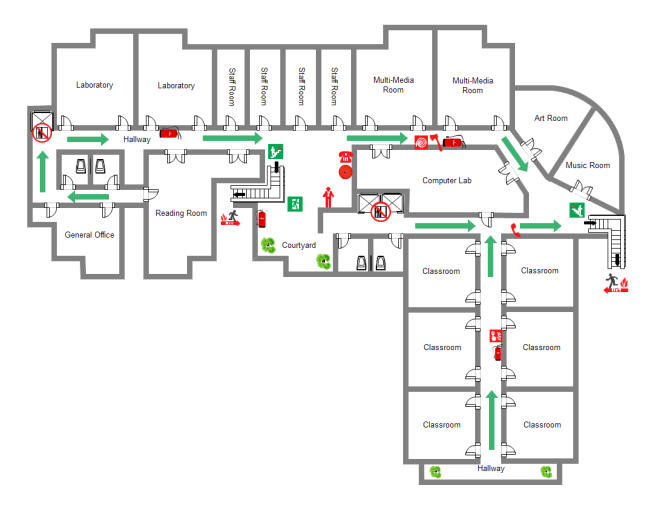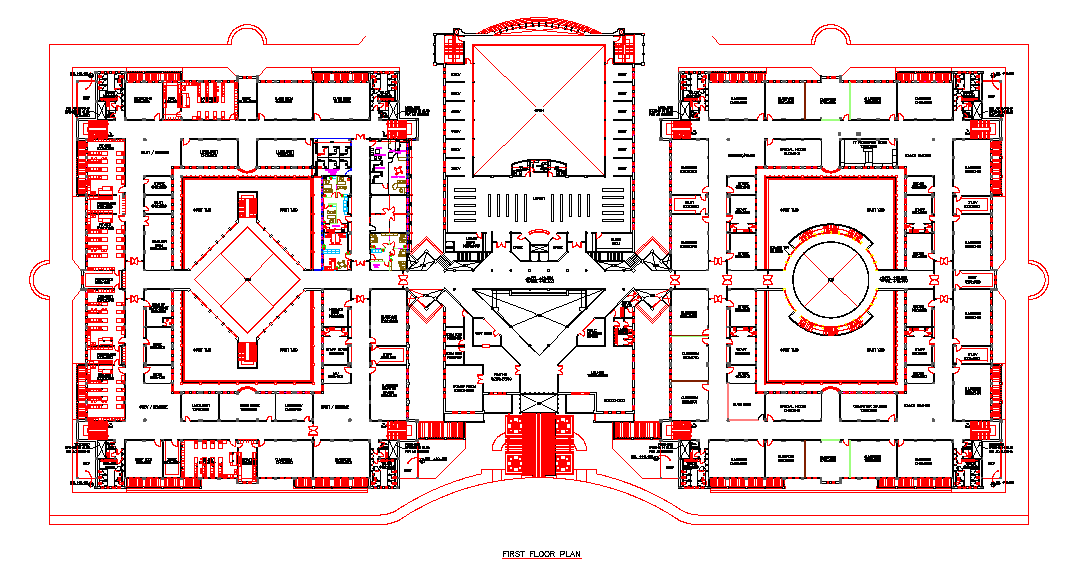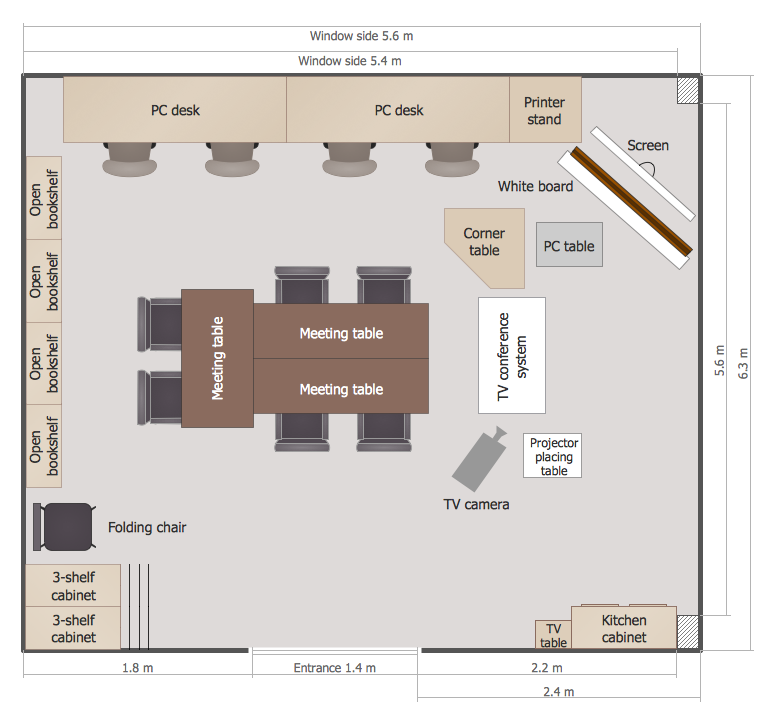Professional School Floor Plan: Tips for Successfully Implementing a New Floor Plan
By Abu Rizal at: April 10, 2020
Selecting the appropriate provider for a school floor plan can be an overwhelming endeavor.
The abundance of diverse types and arrangements can make it challenging to initiate the selection process.
In this article, we will lead you through the fundamental steps of picking the suitable floor plan that meets your requirements.
It is a visual representation of the building's internal structure, including
the location and dimensions of classrooms, offices, common spaces, and other facilities.
A school floor plan is an essential tool for planning and designing a functional and efficient educational environment.
It provides a blueprint for the construction, renovation, and maintenance
of the school building, and helps to ensure the safety and well-being of students, teachers, and staff.
Here are some of the most common types of school floor plans:
including the educational philosophy, teaching style, student needs, available space, and budget.
Each type of floor plan offers different benefits and challenges,
and it is important to select the one that best suits the specific needs of the school and its community.
Here are some steps to follow:
and the overall functionality of the space. Here are some steps to follow when choosing the right layout:
and conducive to learning. Here are some of the most important factors to keep in mind:
Here are some of the key advantages of having a professional school floor plan:
including the size and complexity of the building, the level of detail required in the plan,
and the expertise of the service provider. Here are some of the factors that can impact the cost of creating a school floor plan:
as it can provide a range of benefits that can help to support academic achievement, promote inclusivity
and diversity, improve safety and security, and enhance the overall quality of the learning environment.
While the cost of creating a school floor plan can vary widely depending on a number of factors,
it's important to keep in mind that investing in a high-quality floor plan
can provide significant long-term benefits in terms of improved efficiency, safety, and functionality of the school.
By working with a professional and experienced service provider, schools can ensure that their floor plan meets their specific needs
and requirements, and helps to create a learning environment that is conducive to academic success and personal growth for all students.
The abundance of diverse types and arrangements can make it challenging to initiate the selection process.
In this article, we will lead you through the fundamental steps of picking the suitable floor plan that meets your requirements.
What Is A School Floor Plan?
A school floor plan is a detailed drawing or diagram that illustrates the layout of a school's physical infrastructure.It is a visual representation of the building's internal structure, including
the location and dimensions of classrooms, offices, common spaces, and other facilities.
A school floor plan is an essential tool for planning and designing a functional and efficient educational environment.
It provides a blueprint for the construction, renovation, and maintenance
of the school building, and helps to ensure the safety and well-being of students, teachers, and staff.
Types Of School Floor Plans
There are various types of school floor plans, each designed to suit specific educational needs and teaching styles.Here are some of the most common types of school floor plans:
- Open floor plan This type of floor plan features large, open spaces with minimal walls, doors, and barriers.
- Traditional classroom plan This type of floor plan features classrooms arranged along corridors, with individual rooms separated by walls and doors.
- Modular plan This type of floor plan features classrooms that are built as separate modules and can be arranged in different configurations.
- Combined plan This type of floor plan combines different elements of open and traditional classroom plans.
- Courtyard plan This type of floor plan features a central courtyard or outdoor space surrounded by classrooms and other facilities.
It promotes collaboration, flexibility, and communication among students and teachers.
Open floor plans are often used in modern, progressive schools that emphasize hands-on, project-based learning.
It allows for privacy, concentration, and individualized instruction.
Traditional classroom plans are often used in schools that emphasize lecture-based teaching and standardized testing.
It promotes flexibility, adaptability, and customization of the learning environment.
Modular plans are often used in schools that have changing enrollment numbers, limited space, or special educational needs.
It includes larger common spaces for collaboration, as well as smaller classrooms for individual instruction.
Combined plans are often used in schools that want to balance the benefits of both approaches.
It promotes outdoor learning, connection with nature, and community-building among students and staff.
Courtyard plans are often used in schools located in warm climates or rural areas.
including the educational philosophy, teaching style, student needs, available space, and budget.
Each type of floor plan offers different benefits and challenges,
and it is important to select the one that best suits the specific needs of the school and its community.
How To Hire A School Floorplan Service Provider
When it comes to hiring a school floorplan service provider, there are several key factors to consider to ensure that you select the right one for your needs.Here are some steps to follow:
- Define your needs Before you start looking for a floorplan service provider, you should define your needs and goals for the project.
- Research potential providers Look for floorplan service providers that specialize in designing educational facilities.
- Contact potential providers Once you have a list of potential providers, contact them to discuss your project requirements and get a quote.
- Check their credentials Before you hire a floorplan service provider, make sure they are licensed and insured.
- Evaluate their communication and collaboration skills A good floorplan service provider should be responsive, communicative, and collaborative throughout the design process.
- Consider their design approach and philosophy Each floorplan service provider has their own design approach and philosophy.
- Review their contract Before you sign a contract, review it carefully to ensure it includes all the necessary details, such as scope of work, timeline, payment terms, and warranties.
This may include factors such as the number of students, grade levels, programs offered, available space, budget, and timeline.
You can start by searching online or asking for recommendations from colleagues and other school administrators.
Check their portfolios and reviews to see if they have experience in creating floor plans that meet your specific needs.
Ask about their process, timeline, and pricing structure, and make sure they are transparent about their fees and any additional costs that may arise.
You can also check their professional affiliations and certifications to ensure
they have the necessary skills and knowledge to create safe and functional school environments.
Make sure they listen to your needs, provide regular updates, and incorporate your feedback into their designs.
Make sure their approach aligns with your educational philosophy and goals for the school.
For example, if you value collaborative learning, make sure the provider has experience in designing open floor plans that promote collaboration and teamwork.
Make sure you understand all the terms and conditions before you agree to them.
How To Choose The Right Layout For Your School Floor Plan
Choosing the right layout for your school floor plan can have a significant impact on the learning experience of your studentsand the overall functionality of the space. Here are some steps to follow when choosing the right layout:
- Consider your educational philosophy Your educational philosophy should guide your choice of floor plan layout.
- Assess your teaching style Your teaching style should also be taken into consideration when choosing a floor plan layout.
- Evaluate student needs The needs of your students should also be considered when choosing a floor plan layout.
- Determine the available space The available space and budget should also be taken into account when choosing a floor plan layout.
- Consider the flow of traffic The flow of traffic within the school should also be considered when choosing a floor plan layout.
- Evaluate safety and security concerns Safety and security should also be taken into consideration when choosing a floor plan layout.
- Seek professional guidance: It is always a good idea to seek professional guidance from a floor plan designer or architect when choosing a layout.
If you emphasize hands-on, project-based learning, an open floor plan may be the best option.
If you prioritize lecture-based teaching and individualized instruction, a traditional classroom layout may be more suitable.
If you prefer a more collaborative approach, an open floor plan with shared spaces may be ideal.
If you prefer more structured teaching methods, a traditional classroom layout with individual rooms may be more appropriate.
If you have students with special needs or disabilities, an open floor plan with accessible spaces may be necessary.
If you have a large number of students, a modular layout that can be easily reconfigured may be more practical.
If you have limited space, a modular layout that can be easily adjusted may be more feasible.
If you have a larger budget, a more complex layout with multiple shared spaces and specialized facilities may be possible.
The layout should be designed to minimize congestion and promote easy movement between classrooms, shared spaces, and other facilities.
The layout should be designed to minimize the risk of accidents, such as slips, trips, and falls.
It should also include appropriate safety features, such as emergency exits and fire safety equipment.
They can provide expert advice on the best layout for your specific needs and help you avoid potential pitfalls.
What Factors Should You Consider When Designing Your School's Floor Plan?
When designing your school's floor plan, there are several factors to consider to ensure that the space is functional, safe,and conducive to learning. Here are some of the most important factors to keep in mind:
- Classroom size and layout The size and layout of your classrooms are critical factors in creating an effective learning environment.
- Shared spaces Shared spaces like gyms, libraries, and cafeterias should be designed to accommodate the needs of all students and staff who use them.
- Accessibility It is important to ensure that your school is accessible to all students, including those with disabilities.
- Safety and security Safety and security should be a top priority in designing your school's floor plan.
- Traffic flow The flow of students, staff, and visitors through the school should be carefully considered to prevent congestion and ensure easy access to all areas of the building.
- Natural light and ventilation Natural light and ventilation can have a significant impact on the mood and productivity of students and staff.
- Technology Technology is increasingly important in modern classrooms, so consider how you can incorporate technology into your floor plan.
- Future growth Finally, it's important to consider future growth when designing your school's floor plan.
Consider the number of students per class, the types of activities they will be doing, and the furniture and equipment needed to support their learning.
Consider the size, accessibility, and amenities required to support these spaces.
This means considering factors like wheelchair accessibility, accessible restrooms, and the use of assistive technologies.
This includes factors like emergency exits, fire safety equipment, and security cameras.
Consider how you can maximize these elements in your floor plan to create a healthy and comfortable learning environment.
This might include things like smart boards, computer labs, and charging stations for personal devices.
Make sure that there is room for expansion as your school grows and evolves over time.
Benefits Of A Professional School Floor Plan
A professional school floor plan is an important investment for any educational institution, as it can provide a range of benefits.Here are some of the key advantages of having a professional school floor plan:
- Efficient use of space A professional school floor plan can help to maximize the use of available space, ensuring that classrooms, shared spaces,
- Improved safety and security A professional school floor plan can help to identify potential safety and security hazards,
- Enhanced accessibility A professional school floor plan can help to ensure that the school is designed to be accessible to all students, including those with disabilities.
- Better learning outcomes A professional school floor plan can help to create a learning environment that is conducive to academic achievement,
- Increased energy efficiency A professional school floor plan can help to identify ways to improve the energy efficiency of the school,
- Improved aesthetics A professional school floor plan can help to create a more aesthetically pleasing learning environment,
- Long-term cost savings A professional school floor plan can help to identify ways to reduce long-term costs
and other facilities are organized in the most efficient way possible. This can help to create a more functional and productive learning environment.
and ensure that the school is designed with appropriate measures in place to address these risks.
This can help to create a safer and more secure learning environment for students and staff.
This can help to promote inclusivity and diversity in the learning environment.
by ensuring that classrooms and shared spaces are designed to support a range of learning styles and teaching methodologies.
by incorporating features like natural light, efficient HVAC systems, and sustainable building materials.
This can help to reduce energy costs and support environmental sustainability.
by incorporating design elements that promote creativity, comfort, and inspiration.
associated with building maintenance, energy consumption, and other operational expenses.
This can help to ensure that the school remains financially sustainable over the long term.
The Cost Of Creating A School Floor Plan
The cost of creating a school floor plan can vary widely depending on a number of factors,including the size and complexity of the building, the level of detail required in the plan,
and the expertise of the service provider. Here are some of the factors that can impact the cost of creating a school floor plan:
- Size of the building Larger buildings will generally require more time and resources to create an accurate and detailed floor plan.
- Complexity of the building Schools with unique features like curved walls, unusual room layouts, or complex mechanical systems may require more time
- Level of detail required The level of detail required in a school floor plan can also impact the cost.
- Expertise of the service provider The experience and expertise of the service provider can also impact the cost of creating a school floor plan.
- Additional services Some providers may offer additional services like 3D modeling, interior design, or project management, which can add to the overall cost of the project.
As a result, the cost of creating a floor plan for a large school building may be higher than for a smaller school.
and expertise to create an accurate floor plan. This can increase the cost of the project.
A basic floor plan that shows the layout of rooms and basic features will generally be less expensive than a detailed plan
that includes things like furniture layouts, lighting and electrical systems, and mechanical details.
Providers with more experience and a track record of success may charge more for their services.
Conclusion
a professional school floor plan is an important investment for any educational institution,as it can provide a range of benefits that can help to support academic achievement, promote inclusivity
and diversity, improve safety and security, and enhance the overall quality of the learning environment.
While the cost of creating a school floor plan can vary widely depending on a number of factors,
it's important to keep in mind that investing in a high-quality floor plan
can provide significant long-term benefits in terms of improved efficiency, safety, and functionality of the school.
By working with a professional and experienced service provider, schools can ensure that their floor plan meets their specific needs
and requirements, and helps to create a learning environment that is conducive to academic success and personal growth for all students.
School Layout Free School Layout Templates Suitable For School Floor Plan
|
Battle Creek HS, MI School floor plan, Library floor plan In The Interests Of School Floor Plan
|
ERC Day School Floor Plan Cunningham Childrenu0027s Home Pertaining To School Floor Plan
|
t floor. 3. Elementary school floor plan, Building 7778, firs
|
Gallery of School in Doorn / Spring Architecten +
|
The 3 Best School Layouts for New Elementary Schools Lenmak Exterior
|
Floor Plans For School Buildings Unique Stylish Inspiration 9
|
Example: Prince Andrew High School Floor Plan |
typical floor plan of typical governmental primary school and
|
Gallery of Institute at School of Planning and Architecture
|
Secondary School Floor Plan - Cadbull
|
School Floor Plans
|











